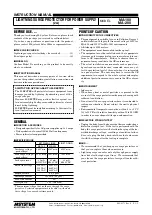
MA-100 / MA-200
5-2-55, Minamitsumori, Nishinari-ku, Osaka 557-0063 JAPAN
Phone: +81(6)6659-8201 Fax: +81(6)6659-8510 E-mail: [email protected]
EM-8171 Rev.8 P. 3 / 3
SURGE ABSORBER ELEMENT
When strong lightning surges exceeding the discharge cur-
rent capacity of the surge protector enter the power supply
cables, it protects the devices to some extent, but its dis-
charge element may fail. The fuse will be blown at the same
time.
Before replacing the fuse, be sure to turn off the power sup-
ply. Turn the fuse holder counterclockwise to extract the
fuse and replace it with a new one. (Refer to the figure be-
low.)
If it recovers to normal after replacing the fuse, you can
continue to use this surge protector. However, if the fuse is
blown again soon after that, it is possible that the surge pro-
tector has failed because of excessive load current. In such
a case, stop using it until a complete testing is done. Follow
the checking procedure explained in the “MAINTENANCE”
section in this manual.
SIDE VIEW
In order to remove the fuse, turn it counterclockwise
and pull it out of its holder.
Use a proper type of fuse which meets M-RESTER model
and its power supply voltage.
PARTS NO.
MODEL NO.
RATING
MA-100 use
200002
FGMB
125V, 2A
MA-200 use
200979
FGMB
250V, 2A
MAINTENANCE
Check surge protectors periodically. Many cases of light-
ning are ignored, and even lightning at a far distance often
causes inductive surges.
We recommend that you check your surge protector about
twice a year, before and after the rainy season. Check
whenever you experience a strong lightning occurrence.
Checking procedure is explained in the following:
■
CHECKING
WIRING
1) Make sure that wiring is done as instructed in the con-
nection diagram.
2) Make sure that the Ground terminal (2, 3, 6 or 7) is con-
nected to the metallic housing of protected device.
3) Make sure that the Ground terminal (2, 3, 6 or 7) is
grounded to earth.
DISCHARGE FUNCTION
Remove all the wires connected to the surge protector and
test its discharge capability as follows:
• MA-100
1) Apply 150V DC across the terminals (1) – (8), and meas-
ure leakage current. (≤ 1mA standard)
Check also that the power indicator LED is ON.
2) Then apply 250V DC and check that the discharging oc-
curs. (≥ 2mA standard)
• MA-200
1) Apply 300V DC across the terminals (1) – (8), and meas-
ure leakage current. (≤ 1mA standard)
Check also that the power indicator LED is ON.
2) Then apply 500V DC and check that the discharging oc-
curs. (≥ 2mA standard)
• MA-100, MA-200
1) Apply 300V DC across the following terminals and meas-
ure leakage current. (≤ 1mA standard)
Terminals (1) – (2), (8) – (2)
2) Then apply 500V DC and check that the discharging oc-
curs. (≥ 2mA standard)
3) If a DC power source is not available, check resistance
across the following terminals (≥10MΩ standard).
Terminals (1) – (8), (1) – (2), (8) – (2)
4) Check that discharging occurs across the same termi-
nals with a 500V DC/1000 MΩ insulation tester. (≤ 20MΩ
standard)
If any of the above tests shows negative, replace the whole
surge protector unit.



